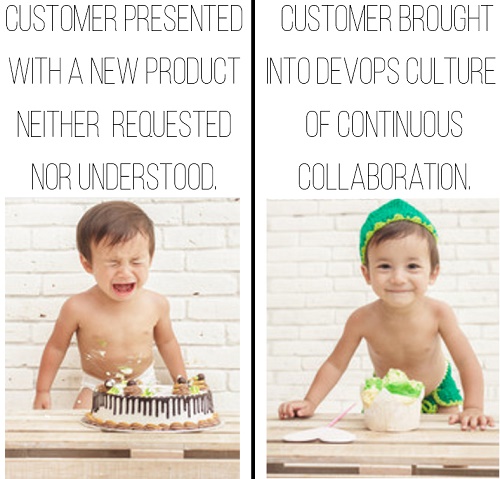You could say that they’ve embraced the DevOps philosophy of ‘turning the power struggle with IT into the power of collaboration.’

Therese Sullivan,
Principal,
|
April 2017 |
[an error occurred while processing this directive] |
| Will DevOps Culture Come to Smart
Buildings? You could say that they’ve embraced the DevOps philosophy of ‘turning the power struggle with IT into the power of collaboration.’ |
 Therese Sullivan, Principal, |

| Articles |
| Interviews |
| Releases |
| New Products |
| Reviews |
| [an error occurred while processing this directive] |
| Editorial |
| Events |
| Sponsors |
| Site Search |
| Newsletters |
| [an error occurred while processing this directive] |
| Archives |
| Past Issues |
| Home |
| Editors |
| eDucation |
| [an error occurred while processing this directive] |
| Training |
| Links |
| Software |
| Subscribe |
| [an error occurred while processing this directive] |
If
software is eating the world, then software development operations
should be of consuming interest to everyone—particularly to
stakeholders in Smart Buildings and other Smart Systems. We should have
already learned the lesson that you need to start product development
from the perspective of end-users—building owners, facilities staff,
and occupants. The last generation of building automation technology
offered enough instances of unplugged BMS systems sitting in corners to
be wary of the possibility of not-my-piece-of-cake reactions to new
technology. How can the industry do better going forward? Or as Brad
White of SES Consulting asked in March “How
do you spec a good user
experience?.” Brad and fellow SES member Christopher have followed up this month with "Cope with
the IOT Revolution by Staying Agile" which explains their thoughts on an implementation of DevOps.
Smart Building product developers could get
in sync with enterprise software innovators and embrace the concept and
culture of DevOps. Modern DevOps methodology emerged in
response to the rise of open-source software, mobile computing and
cloud architectures. Tasks like version control, configuration
management and compliance testing have become more complex, while
pressure to release software products more rapidly, frequently, and
reliably is increasing. The one new point of leverage is that
collaboration tools are a whole lot better. So, DevOps culture was born
out of the idea that software engineers and their IT operations
colleagues can manage the greater complexity and shortened schedules by
working together more seamlessly.
One expert on the topic, Coté, describes DevOps as “the term people use when they mean ‘doing all that new stuff, in new ways.’” That’s helpful? The DevOps Wikipedia page describes it as connecting software engineers and IT staff in a tight DevOps cycle or toolchain.
To add the essential ingredient of customer
empathy, user experience (UX) designers are also core participants in
DevOps. Kai Brunner, the Principal Designer for continuous
delivery
enterprise software at Electric Cloud, describes the dynamic this
way:
“Designers have to not only adapt but
evolve proactively to continue leading with creative decisions and
transform the ‘power struggle’ into the ‘power of collaboration,’ the
same way development and operation teams are achieving this in the
DevOps culture.”
DevOps, User Experience Design (UX Design),
Customer Success Management—is all this actually new? Or is DevOps
culture just a bunch of new names for classic software development and
marketing principals and roles? TBD. But, it’s worth considering the
fit for our industry.
DevOps & Analytics
[an error occurred while processing this directive]Opportunity for DevOps methodology in Smart Buildings may have an opening with the deployment of analytics and visualization programs. In recent years, some building retrofit project teams tried to make an end-run around IT when deploying analytics. For the most part, that strategy has proven short-sighted. Typically, somewhere up the line, a decision-maker has a not-my-piece-of cake reaction, and the analytics project is stymied. In his March article, Jim Lee of Cimetrics makes a good case for avoiding the end-run. He offers this framing:
“See how
analytics brings value to building
owners and operators, after all, they are our customers. The scope of
value-creating features of analytics for owners is growing: energy
management, FDD (Fault Detection and Diagnostics) and continuous
commissioning were a few early areas enabled by analytics. More
recently, we are crossing into corporate functions such as compliance,
forensics, vendor and asset lifecycle management.
On the horizon are more valuable areas for
enterprises: targeting occupants to be more efficient, productive,
cognitively alert and deliver the best for the enterprises which employ
them.”
There are more and more companies in our
industry that, like Cimetrics, see IT as their allies and partners in
satisfying building owner and occupant end users. You could say that
they’ve embraced the DevOps philosophy of ‘turning the power struggle
with IT into the power of collaboration.’
Of course, Cimetrics is a 3rd-party
analytics software developer; so, it is innovating software development
practices all the time. Also, the DevOps concept of a continuous cycle
of planning and doing is coded into its DNA too. Is a DevOps toolchain
so different from a monitoring-based commissioning (MBCx) cycle with
analytics software like Cimetrics Analytika at the core?
There
are many different types of companies in our Smart Building/Smart
System industry including OEMs, control system vendors, controls
contractors, master systems integrators, energy management and
commissioning consultants and service & maintenance firms. What can
DevOps culture offer them? ...
Deploying 3rd-party analytics to the satisfaction of owner and occupant end-users takes customization of the interface for the unique building or campus under management, and sometimes it means developing a custom app. So, some of the most forward-thinking players in each category are recognizing that they need to evolve and funnel their controls expertise into a software engineering role. Training in the DevOps methodology and toolchain could help them bring structure to this new role.
CMMS & Visualization Support Tools Fit In DevOps
Again, ‘DevOps
culture’ is in many ways just a trendy way to describe practices and
tools that are already familiar to Smart Building/Smart System
professionals under different names. For instance, computerized
maintenance management systems (CMMSs) have been around a while,
supporting the same types of activities listed in the DevOps tool
chain. A CMMS helps users track who did what to which piece of
equipment when, etc. BASSG’s Sparko software package, for example, is a
CMMS that works with SkyFoundry’s SkySpark analytics system. Sparko
will map specific SkySpark rules to operations & maintenance
personnel or departments inside a company or to external team members
like an automation contractor or MEP engineer. Basically, it gives
users the flexibility to get corrective action in motion sooner. Tying
analytics to action in this way fits neatly into the DevOps playbook.
This year's Control Trends Awards included
the category '3rd Party Visualization Vendor of the Year' which was won
in a tie by BASSG and DG Logik. These companies are providing HTML 5
platforms for the development of custom user interfaces for smart
system software. Good design principles are baked into their templates,
component libraries and menus. Every small firm creating an energy or
comfort performance optimization app for their building-owner customers
might not have a User Experience (UX) designer on the team, but with
these 3rd-party visualization platforms, you are empowered to make
information as easy and compelling to interpret as possible.
Impact of Continuous SW Delivery
Schedules
on Marketing
I have spent my career in enterprise software marketing and, for me, what is new about DevOps culture, is the idea of letting go of strict product release schedules. Back in the day of print and paper, we timed the release of various customer and market communications with the phases of product development. White papers and trade press articles that described the upcoming market need were released when development was just getting underway; product description brochures and software manuals had to be ready in time for beta release; advertisements and website copy were needed as part of the general availability launch, etc. Today, not only is software being developed and released on a continual basis, communications with the end customer are on-demand too. Digital publishing, social media and search tools have evolved to help marketers cope with the new realities. Webinars and podcasts are part of the new mix too. And soon there will be chatbots and other AI-enhanced aids to help reach customers with messages when they are ready to hear them. As with DevOps, the tools to communicate about a new product introduction get better, but the noise, distractions, and pressures increase too. I think we are left with the same problem: how to make the customer a partner in the cake baking, so that everyone has a sense of anticipation up to the moment it arrives and a sense of satisfaction when they try it.
[an error occurred while processing this directive]
[Click Banner To Learn More]
[Home Page] [The Automator] [About] [Subscribe ] [Contact Us]